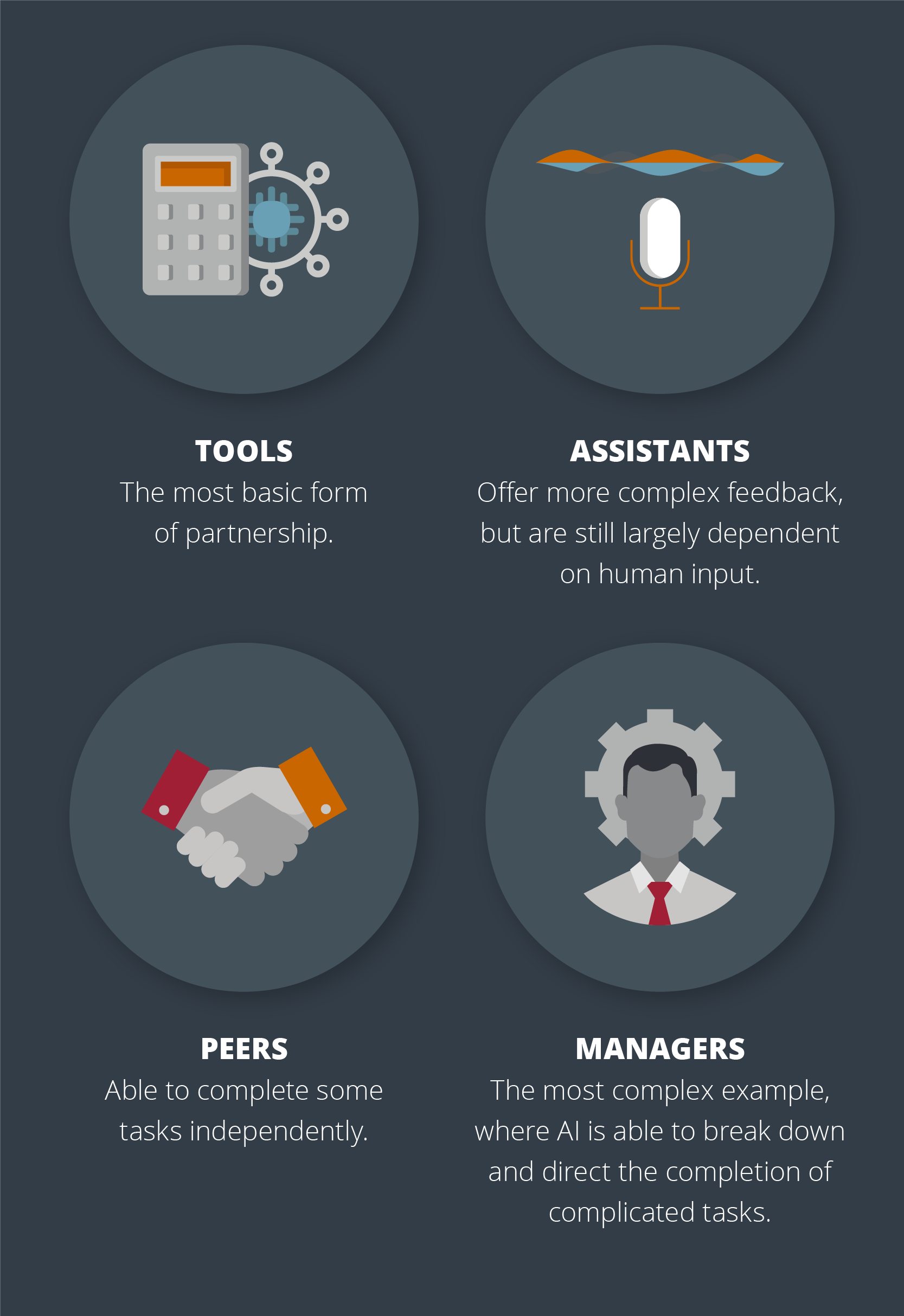What Is Collective Intelligence And Why Should You Use It?
I think information technology in general is one of the most important factors causing changes in business today, and for most people artificial intelligence (AI) is probably the most mysterious kind of information technology. So this course will help demystify AI for students, and give them the confidence and the basic knowledge they need to take advantage of AI in their own organizations.
– Thomas Malone, Patrick J. McGovern (1959) Professor of Management
The concept of collective intelligence (CI) is nothing new – it’s crucial in defining the success of any group endeavor and is used daily in most organizations. When combining artificial intelligence (AI) with collective intelligence, companies can become even stronger, more profitable, and more efficient.
In the Artificial Intelligence: Implications for Business Strategy online short course from the MIT Sloan School of Management and the MIT Computer Science and Artificial Intelligence Laboratory (CSAIL), you’ll learn how AI can support your organization and be integrated to increase efficiency and scalability. In just six weeks, this course provides the background needed to transform your organization into a business of the future. You’ll learn how to harness AI and leadership for strategic decision making, and explore a road map for implementing AI in your business context.
You’ll be exposed to Professor Thomas Malone’s insight and knowledge as the Co-Faculty Director of the program. He is also the founding director of the MIT Center for Collective Intelligence.
Malone explains that groups of people working together create a ‘supermind’ with CI. Essentially, in the same way IQ describes individual intelligence, CI defines a body of knowledge on a broader scale. It’s a dynamic concept, with changes spurred on by the increasing sophistication of AI technologies.
Under this paradigm, human-machine partnerships (AI with human input) enable and enhance CI. Organizations able to capitalize on these possibilities are likely to find a strategic advantage in doing so.
But what exactly does this new vision of CI look like?
Collective intelligence today
The first step in understanding how AI influences CI in business is understanding the different types of intelligence.
By definition, CI refers to a group or a team’s combined capacity and capability to perform various tasks and solve diverse problems. According to Anita Woolley and Ishani Aggarwal, “teams exhibit collective intelligence (CI), defined as a team’s basic capacity to perform a wide variety of tasks, which is consistently predictive of future performance.”1
Broadly speaking, intelligence can be specialized (where you’re able to perform tasks related to a single narrow area of focus) or general (where you’re able to complete tasks across a broad focus area).
When a group of individuals gather for work, there’s a flow to what they’re doing. The group as a whole has CI. When individuals work in isolation, they are limited by their individual intelligence. By adding AI to the mix, the collective minds of the group can be made even more effective.2
“We know that the future of work is all about collaboration and problem-solving,” says Peter Baeck, who leads the Centre for Collective Intelligence Design at Nesta, a UK charity that funds and promotes research into groundbreaking ideas. “One of the most obvious opportunities is using AI to better create connections within often quite chaotic messy networks of people who are working on a common challenge.”3
AI technologies fall into the category of specialized intelligence; the algorithm behind the technology is excellent at completing a single task or type of task, but unable to perform very well beyond that. For example, a machine learning algorithm can be designed to recognize pictures of dogs, but you wouldn’t want the same AI doing your taxes. By contrast, humans possess general intelligence – we can carry out a wide range of tasks successfully, although we may not be as good as AI at specialized tasks.
By pairing AI with humans in human-machine partnerships, it’s possible to overcome the drawbacks of each: a human partner adds versatility, while AI contributes efficiency. Human-computer alliances can take many forms and demonstrate collective intelligence at its best. In his work, Malone provides a useful framework for understanding these interactions, arguing that AI can act as your tool, assistant, peer, or manager in business.
The role of collective artificial intelligence
There are many different examples of how CI works in tandem with AI, but according to Malone, they can be broken down into four primary categories:

Each of these categories has its own pros and cons, and can bolster CI with enhanced intellect in very specific ways.

Collective intelligence as a tool
Much as a hammer is a highly specialized tool for hitting a nail, the simplest expression of the human-machine partnership – the tool – refers to AI’s ability to undertake specific, basic tasks with human input. For example, AI alone can be taught concepts, but you might not want AI to do complex and nuanced work with variables. In most instances, these tasks must be monitored throughout the process with humans, enhancing the partnership and effectiveness of using AI.
Examples of applications include word processors in, for example, your cellphone apps that offer autocomplete functions based on machine learning algorithms. Tools such as these allow humans to manipulate and communicate information more efficiently, and leverage collaboration between humans and machines on a larger scale.
Malone calls this large-scale collaboration ‘hyperconnectivity’. As he explains in the course: “This may well be the most important way information technology helps create more intelligent organizations.”

Collective intelligence paired with AI offers everyday assistance
The next step on the ladder – assistants – can operate with a slightly greater degree of independence. A powerful example of this application takes its description very seriously: AI assistants.
Best known for their ubiquity in smartphones (such as Google’s Assistant, Apple’s Siri, and Amazon’s Alexa), AI assistants are making important inroads in business settings, where they’re being used across a broad range of industries to augment human skills. For instance, Windows’ Cortana streamlines its users’ day by providing contextually appropriate information, sending files, and even scheduling and confirming appointments. This makes it easier for professionals to focus on other business-critical tasks.4

Artificial intelligence takes on a peer role with collective intelligence
The third rung of human-computer interaction places AI in the role of a peer. Essentially, this means that humans and AI perform the same or similar tasks. Machines are often able to perform these tasks much quicker than humans, but humans can solve problems that fall outside the scope of AI programming. Therefore, peer interactions often have a human partner overseeing and checking the operation of an AI application, doing only what is necessary.
Robotics provides an excellent example of human-computer interaction at the peer level. In many modern warehouses, autonomous robots bring goods to workers, cutting down on time spent walking the floor and searching for products. The human end of this interaction is still needed to make sure the correct product is retrieved.5
In another application, the predictions of AI and humans are combined to forecast the next play in a game of football.6 The combined predictions prove to be more accurate and robust, showing AI’s potential in contexts such as forecasting cybercrime or market conditions.

AI managers increase task efficiency utilizing collective intelligence
Although frightening to some, the concept of AI managers is a reality we already experience on a day-to-day basis – just look at traffic lights, which are controlled by algorithmic systems.7
The role of AI as managers can include a simple division of labor – breaking tasks into smaller subtasks and assigning them to human workers best suited to them. The machine, in this case, essentially acts as a coordinator, using data to ensure a task is performed as efficiently and effectively as possible. Although these systems rely on sophisticated machine learning algorithms, when used correctly, they can lead to vastly improved operational performance – all thanks to augmented CI, or human-machine partnerships. For example, the use of AI in healthcare, as explained in the MIT Sloan Artificial Intelligence in Health Care online short course, can help with diagnosis and patient monitoring.
The future of collective intelligence combines humans with AI
CI is on display in virtually every business, every day, although few may be aware of it. AI represents the opportunity for companies to augment CI in very real ways, improving their operations and strategic performance. But the human element remains vital – while many fear that AI will replace humans, the more likely future will see humans and computers interact in complex ways to improve the performance of both.
As augmented intelligence advances, business will evolve and scale with it – and for those who stand at the leading edge of this process, the rewards will be great. The American Medical Association defines augmented intelligence as “a conceptualization of artificial intelligence that focuses on AI’s assistive role, emphasizing that its design enhances human intelligence, rather than replaces it.”8 This concept is thoroughly covered in the MIT Sloan Building and Scaling Intelligent Enterprises With Artificial Intelligence online short course.
As Malone says, “All uses of computers occur within the context of people.” The two work together to help solve problems and accelerate business. In the future, Malone anticipates that AI will be implemented by more businesses and have an increasingly significant impact: “We believe that businesses should focus on applying AI in ways that don’t just replace people, but that create new jobs by providing novel kinds of products and services,” he says. “We recommend that all schools include computer literacy and computational thinking in their curricula, and we believe that community colleges should offer more reskilling and online micro-degree programs, often including apprenticeships at local employers.”9
Below, Malone explains the importance of working with AI to complement CI.
Featured faculty

THOMAS W. MALONE
Patrick J. McGovern (1959) Professor of Management, MIT Sloan School of Management; Founding Director, MIT Center for Collective Intelligence
Malone is a professor of information technology and organizational studies at the MIT Sloan School of Management, and his research focuses on how new organizations can be designed to take advantage of the possibilities provided by information technology.
He has published his groundbreaking research in The Future of Work and over 100 articles, research papers, and book chapters. His newest book, Superminds, appeared in May 2018. In addition, he holds 11 patents, co-founded three software companies, and is quoted in numerous publications such as Fortune, the New York Times, and Wired.
Browse the full range of innovative online programs from MIT Sloan.
- 1Woolley, A. & Aggarwal, I. (Jan, 2020). ‘Collective intelligence and group learning’. Retrieved from Oxford Handbooks.
- 2Gent, E. (May, 2020). ‘How AI can help us harness our “collective intelligence”’. Retrieved from BBC.com.
- 3Gent, E. (May, 2020). ‘How AI can help us harness our “collective intelligence”’. Retrieved from BBC.com.
- 4 Rewari, M. (Sep, 2020). ‘What’s new with Cortana, your personal productivity assistant’. Retrieved from Microsoft.
- 5 Hao, K. (Aug, 2021). ‘A new generation of AI-powered robots is taking over warehouses’. Retrieved from MIT Technology Review.
- 6(Sep, 2021). ‘Quarter4 launches real-time AI-powered predictions for 2021 NFL & NCAA football seasons’. Retrieved from Yahoo.
- 7Dave, P. (Oct, 2021). ‘Google wants to use AI to time traffic lights more efficiently’. Retrieved from Reuters.
- 8(Nd). ‘Augmented intelligence in medicine’. Retrieved from AMA. Accessed December 1, 2021.
- 9(Jan, 2021). ‘3 Questions: Thomas Malone and Daniela Rus on how AI will change work’. Retrieved from MIT News.